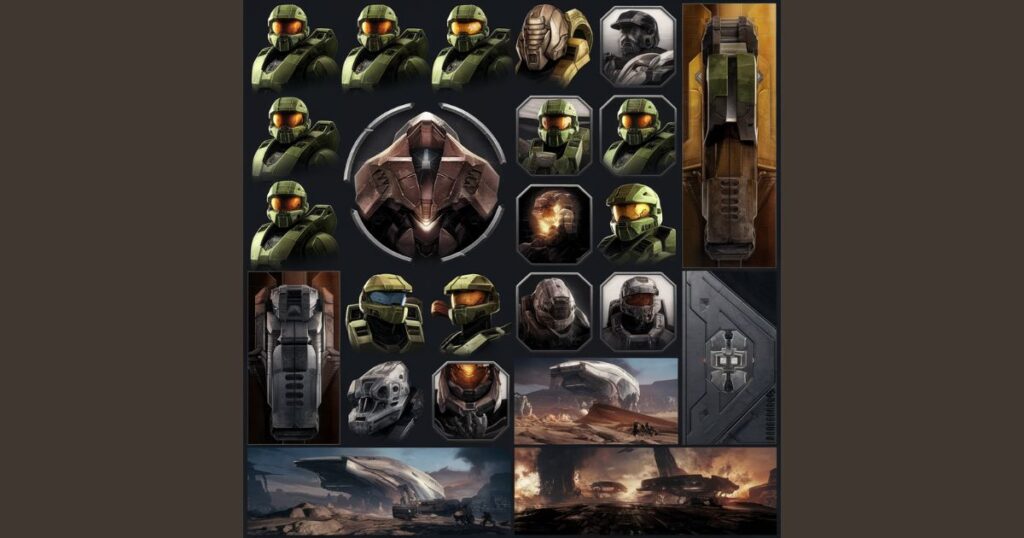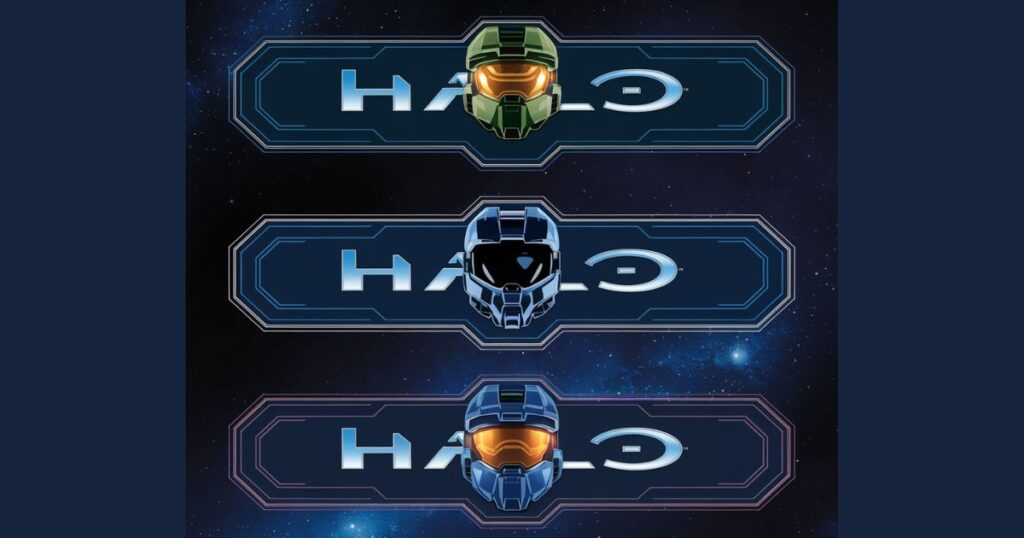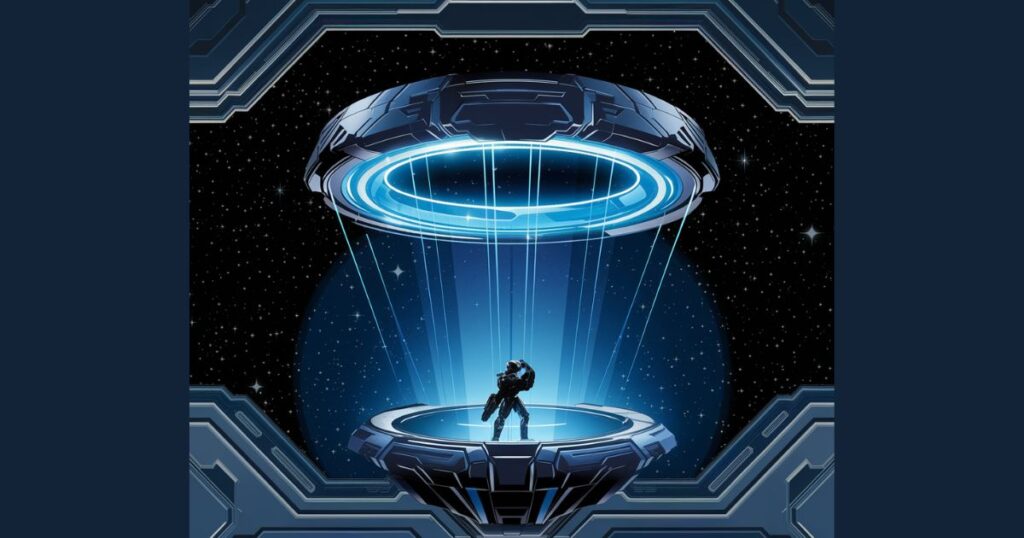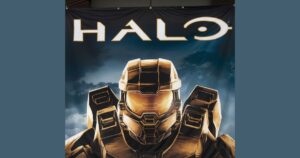In the vast universe of video games, few titles have left as indelible a mark as Halo. Released in 2003 for the Xbox console, Halo: Combat Evolved didn’t just redefine the first-person shooter genre; it revolutionized the way we think about game iconography and visual design.
At the heart of this revolution were the Halo (2003) game icons and banners – visual elements that transcended their functional roles to become cultural touchstones. Let’s dive deep into the world of Halo’s visual language and explore how these seemingly simple designs shaped an entire gaming generation.
The Birth of a Gaming Icon
When Bungie Studios unleashed Halo: Combat Evolved onto the gaming world, they didn’t just release a game – they ignited a phenomenon. The year 2003 saw the Xbox-exclusive title cement its place in gaming history, and a significant part of its success can be attributed to its striking visual identity.
The Halo (2003) game icons and banners weren’t mere decorative elements. They were the building blocks of an immersive universe that players could instantly recognize and connect with. Imagine booting up your Xbox for the first time and being greeted by the imposing silhouette of Master Chief, the game’s protagonist.
This wasn’t just clever marketing. It was the beginning of a visual journey that would captivate gamers for decades. The iconic helmet of the Spartan super-soldier became more than just a character design – it evolved into a symbol of heroism, resilience, and the fight against overwhelming odds.
But why do these visual elements matter so much? In the fast-paced world of gaming, where split-second decisions can mean the difference between virtual life and death, clear and instantly recognizable icons are crucial. Halo (2003) didn’t just nail this aspect; it set a new standard for how games could communicate with players through visual shorthand.
As we embark on this exploration of Halo’s visual legacy, we’ll uncover how these icons and banners shaped not just the game itself but the entire landscape of gaming culture. From the battlefields of alien worlds to the bedrooms of devoted fans, the impact of Halo’s visual language extends far beyond the confines of the game screen.
Read This Article: Who Is The Richest YouTuber in 2024?
What are Icons in Halo (2003)?
In the context of Halo (2003), icons serve as a visual language that bridges the gap between the player and the game world. These small yet powerful graphics are the silent guides that help players navigate the complex universe of Halo without breaking immersion. But what exactly are these icons, and why are they so crucial to the Halo experience?
At their core, Halo (2003) icons are simplified representations of in-game elements. They range from weapon symbols that allow quick identification during frantic firefights to status indicators that keep players informed about their health and shield levels. The beauty of Halo’s iconography lies in its elegant simplicity – each icon is distilled to its essence, allowing for instant recognition even in the heat of battle.
Let’s break down some key examples:
- The Assault Rifle Icon: Perhaps one of the most recognizable symbols in the game, this icon represents Halo’s workhorse weapon. Its sleek, angular design mimics the actual in-game model while being distinct enough to stand out in the weapon selection menu.
- The Energy Sword Icon: This Covenant weapon’s icon is a masterclass in visual storytelling. Its glowing, curved design instantly communicates the alien and dangerous nature of the weapon.
- The Shield Recharge Icon: A simple yet effective design that uses concentric circles to represent the recharging of the player’s energy shields. Its pulsing animation provides crucial feedback during gameplay.
- The Scorpion Tank Icon: This icon manages to convey the power and bulk of the UNSC’s main battle tank in just a few pixels, making it instantly recognizable on the game’s minimap.
These icons play a vital role in Halo’s user interface, allowing players to make split-second decisions without having to read text or decipher complex symbols. They’re not just functional; they’re an integral part of Halo’s visual storytelling, each one adding to the rich tapestry of the game’s sci-fi universe.
The genius of Halo’s icon design lies in its consistency. Whether you’re looking at a weapon pickup, a vehicle on your HUD, or an objective marker, the visual language remains coherent. This consistency helps players quickly learn and internalize the meaning of each icon, enhancing the overall gameplay experience.
Types of Banners in Halo (2003)
While icons in Halo (2003) served as the game’s visual vocabulary, banners acted as its grand statements. These larger graphical elements played a crucial role in world-building, marketing, and community engagement. Let’s explore the various types of banners that helped shape the Halo universe.
In-game Banners: Building the World of Halo
In-game banners in Halo (2003) were more than just pretty pictures. They were storytelling devices. These visual elements helped create a sense of place and history within the game world. For instance, UNSC bases featured military-style banners that reinforced the game’s militaristic themes. These banners often displayed the UNSC logo or motivational slogans, adding depth to the game’s lore.
Covenant structures, on the other hand, featured banners with alien glyphs and symbols. These served to highlight the mysterious and foreign nature of the Covenant civilization. The contrast between human and alien banners subtly reinforced the game’s central conflict.
Promotional Banners: How Bungie Hyped the Game
Outside the game, promotional banners played a pivotal role in Halo’s marketing strategy. These banners, often featuring the iconic Master Chief or dramatic battle scenes, were plastered across websites, magazines, and billboards. They were designed to catch the eye and spark curiosity, often featuring taglines that hinted at the epic scale of the game’s story.
One particularly effective promotional banner showed Master Chief standing alone against a backdrop of the Halo ring, perfectly encapsulating the game’s themes of heroism and discovery. These banners didn’t just advertise the game; they sold an experience, promising players the chance to become a legendary hero in a vast, unknown universe.
Online Banners: Uniting the Halo Community
As online gaming communities grew, so did the importance of online banners. These digital flags served as rallying points for Halo fans across the internet. Forum signatures, clan banners, and website headers all featured Halo-inspired designs, allowing fans to display their allegiance to the franchise proudly.
Bungie itself used online banners to great effect, creating special designs for community events, tournaments, and game updates. These banners helped create a sense of shared identity among Halo players, fostering a community that remains passionate and engaged to this day.
Environmental Banners: Storytelling through Scenery
Within the game world, environmental banners added depth and realism to Halo’s settings. Whether it was tattered UNSC flags in abandoned bases or holographic Covenant banners in alien structures, these elements helped bring the game’s environments to life.
They served as silent storytellers, hinting at the history and culture of the game’s factions without the need for explicit exposition. The use of banners in Halo (2003) demonstrates the power of visual design in creating a cohesive and immersive game world.
From hyping up the game’s release to uniting fans online, these banners played a multifaceted role in Halo’s success. As we continue our exploration of Halo (2003) game icons and banners, we’ll see how these visual elements evolved and influenced the broader gaming landscape.
Design Elements of Halo (2003) Icons
The icons in Halo (2003) are a masterclass in efficient visual communication. Each icon needed to be instantly recognizable, convey essential information and fit within the game’s overall aesthetic. Let’s break down the key design elements that made Halo’s icons so effective.
The Unforgettable Assault Rifle Symbol
The Assault Rifle icon is perhaps one of the most recognizable symbols in Halo (2003). Its design is a perfect example of how Halo’s icons balanced simplicity with detail:
- Silhouette: The icon uses a distinct silhouette that mirrors the weapon’s actual in-game model. This allows for instant recognition even at small sizes.
- Detail: Despite its simplicity, the icon includes key details like the weapon’s scope and magazine, making it unmistakably the Assault Rifle.
- Color: The icon uses a neutral color scheme, allowing it to stand out against various backgrounds without clashing with the game’s UI.
Covenant Weapons: Alien Designs that Pop
The icons for Covenant weapons presented a unique challenge: how to represent alien technology in a way that players could quickly understand. The designers at Bungie rose to this challenge brilliantly:
- Organic Shapes: Covenant weapon icons feature more curved, organic shapes, contrasting with the angular designs of human weapons. This visual distinction helps players instantly differentiate between UNSC and Covenant weaponry.
- Energy Representation: Many Covenant weapons use energy projectiles, represented in the icons by glowing elements or pulsing designs.
- Exotic Silhouettes: The unique shapes of Covenant weapons like the Needler or Energy Sword are emphasized in their icons, making them instantly recognizable.
Power-ups and Special Items: Visual Shorthand for Game-changing Moments
Halo (2003) featured various power-ups and special items, each needing its own distinct icon:
- Overshield: Represented by a glowing, hexagonal shield design, instantly communicating enhanced protection.
- Active Camouflage: Depicted as a shimmering outline, visually representing the item’s cloaking effect.
- Health Pack: A simple red cross design, universally recognized as a symbol for healing.
These icons needed to be quickly identifiable in high-pressure gameplay situations, and their designs achieved this goal admirably.
Read This Article: Joe Rogan’s Wife: All About Jessica Ditzel
UI Elements: Shields, Health, and Ammo Indicators
The user interface in Halo (2003) was a crucial part of the gameplay experience, and its icons played a vital role:
- Shield Bar: Represented by a blue, segmented bar that depleted as the player took damage. Its position at the top center of the screen made it easy to monitor at a glance.
- Health Indicator: Shown beneath the shield bar, this element used a traditional heart icon to represent the player’s remaining health.
- Ammo Counter: A simple numerical display accompanied by an icon representing the current weapon type.
These UI elements were designed to provide crucial information without cluttering the screen or distracting from the gameplay. The design elements of Halo’s (2003) icons showcase the careful balance between aesthetics and functionality.
Each icon needed to be visually appealing while also serving a clear purpose within the game. This attention to detail in icon design contributed significantly to Halo’s intuitive gameplay experience and has influenced game design far beyond the Halo franchise.
As we continue our exploration of Halo (2003) game icons and banners, we’ll see how these design principles were applied to larger graphical elements and how they evolved throughout the series.
Artistic Themes in Halo (2003) Banners

The banners in Halo (2003) were more than just decorative elements. They were powerful tools for storytelling and world-building. These larger graphical elements allowed the artists at Bungie to flex their creative muscles, creating visuals that were both stunning and meaningful. Let’s delve into the artistic themes that defined Halo’s banner designs.
Sci-fi Aesthetics: Blending Familiar and Alien Designs
Halo’s universe is a unique blend of familiar military sci-fi and truly alien elements. This duality is reflected beautifully in the game’s banner designs:
- UNSC Banners: These often featured strong, angular designs reminiscent of real-world military insignias. The use of bold, solid colors like navy blue and olive green reinforced the military theme. The UNSC logo, with its eagle motif and Earth imagery, struck a balance between futuristic design and recognizable military symbolism.
- Covenant Banners: In stark contrast, Covenant banners embraced the alien. They featured flowing, organic shapes and vibrant, otherworldly colors. Glyphs and symbols that looked both mystical and technological adorned these banners, hinting at the Covenant’s blend of religious fanaticism and advanced technology.
This juxtaposition of human and alien aesthetics in the banner designs helped reinforce the game’s central conflict visually.
Color Theory: Why Halo’s Palette Works So Well
The color choices in Halo (2003) banners were far from arbitrary. The game’s artists used color theory to create impactful designs:
Colors | Design |
| UNSC Colors | Earth tones, blues, and greens dominated UNSC banners. These colors evoked feelings of strength, stability, and a connection to humanity’s home planet. |
| Covenant Colors | Purples, blues, and bright greens were prominent in Covenant designs. These colors felt alien and exotic, with purple particularly becoming synonymous with Covenant technology. |
| Contrast and Visibility | Whether in-game or in promotional materials, Halo’s banners used high-contrast color schemes to ensure visibility and readability, even from a distance or in the heat of battle. |
Composition: Creating Impact and Telling Stories Through Imagery
The composition of Halo’s banners was carefully crafted to maximize their visual impact and storytelling potential:
- Promotional Banners: These often featured Master Chief prominently, usually in dynamic poses that conveyed action and heroism. The composition frequently placed the Spartans against vast, awe-inspiring backgrounds like the Halo ring or alien landscapes, emphasizing the epic scale of the game’s story.
- In-game Banners: Environmental banners within the game use composition to add depth to the world. Tattered UNSC flags in abandoned bases told stories of desperate battles, while imposing Covenant banners in their structures conveyed the alien faction’s power and presence.
Typography: The Unsung Hero of Halo’s Visual Identity
While not strictly part of the banner designs, the typography used in conjunction with Halo’s banners played a crucial role in the game’s visual identity:
- UNSC Typography: Clean, sans-serif fonts were often used for UNSC-related text, evoking a sense of efficiency and modernity.
- Covenant Typography: When text was used in Covenant designs, it often mimicked the alien glyphs seen in the game, maintaining the mysterious and foreign feel of the faction.
- Logo Typography: The Halo logo itself, with its distinctive font and ring-shaped ‘O’, became an iconic piece of gaming typography, instantly recognizable even without any accompanying imagery.
The artistic themes in Halo’s (2003) banners demonstrate the power of thoughtful visual design in creating a cohesive and immersive game world. By carefully considering aesthetics, color theory, composition, and typography, Bungie created banner designs that didn’t just look good.
They helped tell the story of Halo and draw players deeper into its universe. As we continue our exploration of Halo (2003) game icons and banners, we’ll see how these artistic themes evolved throughout the series and influenced the broader gaming industry.
Evolution of Icons and Banners in the Halo Series
The journey of Halo’s visual identity from its 2003 debut to modern installments is a fascinating study of the evolution of game design. As technology advanced and the Halo universe expanded, its icons and banners underwent significant changes while striving to maintain the essence that made them iconic in the first place.
From Halo (2003) to Modern Installments: A Visual Journey
The original Halo: Combat Evolved set the standard with its clean, functional icons and impactful banners. As the series progressed, we saw a gradual increase in detail and complexity:
- Halo 2 (2004): Building on the original’s foundation, Halo 2 introduced more detailed weapon icons and expanded the range of multiplayer emblems. The game’s promotional banners became more cinematic, often featuring multiple Spartans to highlight the expanded multiplayer focus.
- Halo 3 (2007): With the jump to Xbox 360, Halo 3 brought higher resolution icons and banners. The weapon icons became more detailed, with subtle texturing that wasn’t possible in earlier games. Banner designs became more elaborate, often incorporating multiple elements to showcase the epic scale of the concluding chapter in the original trilogy.
- Halo: Reach (2010): As a prequel, Reach introduced a gritty, more militaristic aesthetic to its icons and banners. Weapon icons featured more wear and tear, while banners often incorporated elements of sacrifice and desperation, reflecting the game’s darker tone.
- Halo 4 (2012): Under 343 Industries, Halo 4 saw a significant visual overhaul. Icons became more stylized and sleek, with a greater emphasis on sci-fi elements. Banners and promotional materials leaned heavily into the “man vs. machine” theme, with striking visuals of Master Chief against Forerunner technology.
- Halo 5: Guardians (2015) and Halo Infinite (2021): These latest installments further refined the visual language of Halo. Icons became even more detailed and dynamic, often featuring subtle animations in menu screens. Banners and promotional materials embraced a blend of nostalgia and innovation, balancing callbacks to classic Halo imagery with new design elements that pushed the series forward.
How Technology Advancements Influenced Icon and Banner Design
The leap from the original Xbox to modern gaming systems had a profound impact on Halo’s visual design:
- Increased Resolution: As display technology improved, designers could add more detail to icons without losing clarity. What began as simple, pixelated designs in Halo (2003) evolved into intricate, almost photorealistic icons in later games.
- Dynamic Elements: Modern hardware allowed for animated icons and banners, adding a new dimension to the visual experience. Weapon icons subtly pulse or glow, while banners feature moving backgrounds or particle effects.
- 3D Rendering: Later Halo games could render 3D models in real-time for menu screens, allowing for more dynamic and interactive icon displays. Players could rotate and examine weapons or characters in detail, a far cry from the static icons of 2003.
- Lighting and Effects: Advanced graphics capabilities allowed for more sophisticated use of lighting and special effects in banner designs, creating more atmospheric and immersive visuals.
Maintaining Consistency While Pushing Boundaries
One of the biggest challenges in evolving Halo’s visual identity was maintaining recognizability while embracing new design possibilities:
- Core Symbols: Certain elements, like Master Chief’s helmet design or the basic shape of the Assault Rifle icon, remained relatively consistent throughout the series. These acted as visual anchors, maintaining a connection to the original game even as other elements changed.
- Color Palette: While each game introduced new shades and effects, the core color associations (like blue for UNSC and purple for Covenant) remained largely consistent, helping to maintain visual continuity.
- Thematic Consistency: Even as art styles evolved, the underlying themes of Halo’s visual design the contrast between human and alien technology, the sense of scale, and epic conflict remained constant.
- Balancing Nostalgia and Innovation: Later games often included “classic” icon and banner options, allowing players to switch between modern and retro visual styles. This approach satisfied long-time fans while still pushing the visual design forward.
Impact of Icons and Banners on Fan Culture

The influence of Halo’s (2003) iconic visual elements extends far beyond the game itself, profoundly shaping fan culture and creative expression. Let’s dive into how these seemingly simple designs sparked a revolution in gaming fandom.
Cosplay and Fan Art: Bringing Halo to Life
Halo’s distinctive visual style, established by its icons and banners, provided fertile ground for fan creativity:
- Cosplay Revolution: The iconic design of Master Chief’s armor, so clearly defined in the game’s promotional banners, became a holy grail for cosplayers. Fans spent countless hours crafting intricate Spartan suits, often incorporating LED lights to mimic the game’s energy shields. The popularity of Halo cosplay at conventions helped bring gaming culture into the mainstream.
- Fan Art Explosion: From detailed digital paintings to quick sketches, Halo-inspired fan art flooded the internet. Artists often used the game’s iconic symbols and banner designs as starting points, reimagining them in various styles and contexts. This proliferation of fan art helped keep the Halo community engaged between game releases and showcased the deep connection fans felt to the game’s visual identity.
Wearing Your Spartan Pride: Halo Merchandise
The instantly recognizable nature of Halo’s icons made them perfect for merchandise:
- T-shirts and Apparel: Clothing featuring the UNSC logo, Covenant symbols, or stylized weapon icons became must-have items for fans. These allowed players to display their allegiance to the Halo universe in their everyday lives.
- Collectibles: From replica Energy Swords to detailed figurines of iconic vehicles, Halo’s distinct visual language translated well into physical collectibles. The attention to detail in these items often mirrored the care put into the original game icons.
Memes and Internet Culture: Halo’s Lasting Digital Footprint
Halo’s icons and banners became part of the internet’s visual vocabulary:
- Meme Generation: Images like the Mark V helmet or the Energy Sword icon became shorthand for gaming prowess or sci-fi references in online discussions.
- Forum Signatures and Avatars: Fans used Halo imagery to personalize their online presence, with forum signatures often featuring elaborate banner-like designs incorporating game icons.
Community-Created Content Inspired by Halo’s Iconography
The game’s visual language inspired fans to create their own content:
- Custom Maps and Mods: Halo’s modding community often incorporated the game’s iconic visuals into their creations, using familiar symbols to guide players through custom-made levels.
- Machinima: Series like “Red vs. Blue” used Halo’s in-game assets, including its iconic character designs and environments, to create entirely new narratives.
- Fan Games and Projects: Inspired by Halo’s visual style, fans created their own games and interactive experiences, often using familiar icons and banner designs as a starting point.
Marketing and Branding Through Icons and Banners
The visual language established by Halo (2003)’s icons and banners became a powerful tool for marketing and branding, not just for the game itself but for the entire Xbox platform. Let’s explore how these visual elements shaped one of gaming’s most successful marketing strategies.
The Master Chief’s Helmet: More than Just a Cool Design
The iconic Mjolnir helmet worn by Master Chief is perhaps the most recognizable symbol of the Halo franchise:
- Brand Ambassador: The helmet became a de facto mascot for Halo, instantly recognizable even to those who hadn’t played the game. Its sleek, futuristic design encapsulated the essence of Halo’s sci-fi military aesthetic.
- Versatile Symbol: Whether rendered in great detail for cinematic trailers or simplified for merchandise, the helmet’s basic shape remained consistent and identifiable, making it an incredibly versatile marketing asset.
- Emotional Connection: For many fans, the helmet represented not just a character but the idea of being a hero against impossible odds. This emotional resonance made it a powerful symbol in marketing campaigns.
How Halo’s Visual Identity Became Synonymous with Xbox
Halo’s success was inextricably linked with the Xbox brand:
- Console Seller: Halo (2003) was a system seller for the original Xbox, and its visual elements featured prominently in console bundle packaging and advertisements.
- Xbox Live Icon: As Xbox Live launched, Halo 2’s multiplayer became a flagship title. The game’s icons and banners were often used to represent online gaming in Xbox marketing materials.
- Green and Black: Halo’s color scheme, particularly the green of Master Chief’s armor, aligned perfectly with Xbox’s brand colors, creating a visual synergy between the game and the platform.
Cross-media Promotion: Halo Icons in Books, Comics, and Movies
Halo’s iconic visual elements transcended the gaming medium:
- Book Covers: Halo novels often featured stylized versions of game icons and banner designs, creating a consistent look across different media.
- Comic Adaptations: Graphic novels and comics used familiar icons and designs to ground their stories in the Halo universe, even when exploring new narratives.
- Movie and TV Projects: While a Halo movie hasn’t materialized, various TV projects and anime adaptations have leaned heavily on the established visual language of the games.
Technical Aspects of Creating Icons and Banners
The creation of Halo (2003)’s iconic visual elements was a testament to the technical skill and artistic vision of Bungie’s design team. Let’s delve into the technical aspects of crafting these influential icons and banners.
Tools and Software Used in the Design Process
In the early 2000s, the toolkit for game designers was quite different from today:
- Adobe Photoshop: This was (and still is) a staple for creating and editing 2D graphics. Designers likely used Photoshop to craft detailed icons and banner designs.
- 3D Modeling Software: Programs like 3ds Max or Maya were probably used to create 3D models of weapons and characters, which could then be rendered into 2D icons.
- Proprietary Tools: Bungie likely developed in-house software for integrating these designs into the game engine and ensuring they displayed correctly across different resolutions.
Balancing Aesthetics with Functionality in UI Design
Creating effective icons and banners for Halo (2003) required a delicate balance:
- Clarity at Small Sizes: Icons needed to be recognizable even when rendered at low resolutions on CRT televisions, the standard display of the time.
- Color Constraints: The limited color palette of early console hardware meant designers had to be creative in using contrast and shading to make icons pop.
- Loading Times: Large, detailed graphics could impact game performance, so designers had to optimize their creations to minimize file sizes without sacrificing visual quality.
- Consistency Across Menus: Icons and banners needed to look good not just in-game, but across various menu screens and UI elements.
Adapting Designs for Different Platforms and Resolutions
Halo (2003) was designed primarily for the original Xbox, but its visual elements needed to work across various media:
- Console UI: Icons had to be crisp and clear on both standard and high-definition TVs of the era.
- Print Media: Banner designs and icons need to be translated well into magazine advertisements and game packaging.
- Web Graphics: As online gaming communities grew, Halo’s visual elements had to be adaptable for use in web forums and fan sites.
The Challenge of Creating Memorable Icons with Limited Pixels
The technical limitations of 2003 gaming hardware presented unique challenges:
- Pixel Art Techniques: Designers often had to work at the pixel level, carefully crafting each icon to ensure clarity even at small sizes.
- Silhouette Design: Creating distinct silhouettes for each icon was crucial for quick recognition during fast-paced gameplay.
- Color Psychology: With limited color options, designers had to be strategic in their color choices to convey information effectively.
- Animation Constraints: Any animated elements in the UI had to be simple enough to run smoothly without impacting game performance.
Cultural Significance of Halo Icons and Banners

The impact of Halo (2003)’s visual elements extends far beyond the realm of gaming, permeating popular culture and leaving an indelible mark on the collective imagination.
The cultural significance of Halo (2003)’s icons and banners lies in their ability to transcend their original context. What began as design elements for a video game became touchstones of an entire era of digital culture. They represent not just a game but a pivotal moment in the evolution of interactive entertainment.
These visual elements have become part of our cultural vocabulary, instantly evoking ideas of heroism, advanced technology, and epic interstellar conflict. Their influence can be seen in the design language of countless games, films, and other media that followed.
Moreover, the enduring popularity of Halo’s imagery speaks to the power of effective visual design in creating lasting cultural impact. Two decades after their introduction, these icons and banners continue to resonate with audiences, bridging generational gaps and uniting diverse communities.

Alexander Stone, an avid lifestyle enthusiast, shares insights on wellness, travel, and personal growth at LifestyleTalk. Join him on a journey to enrich your everyday life.








